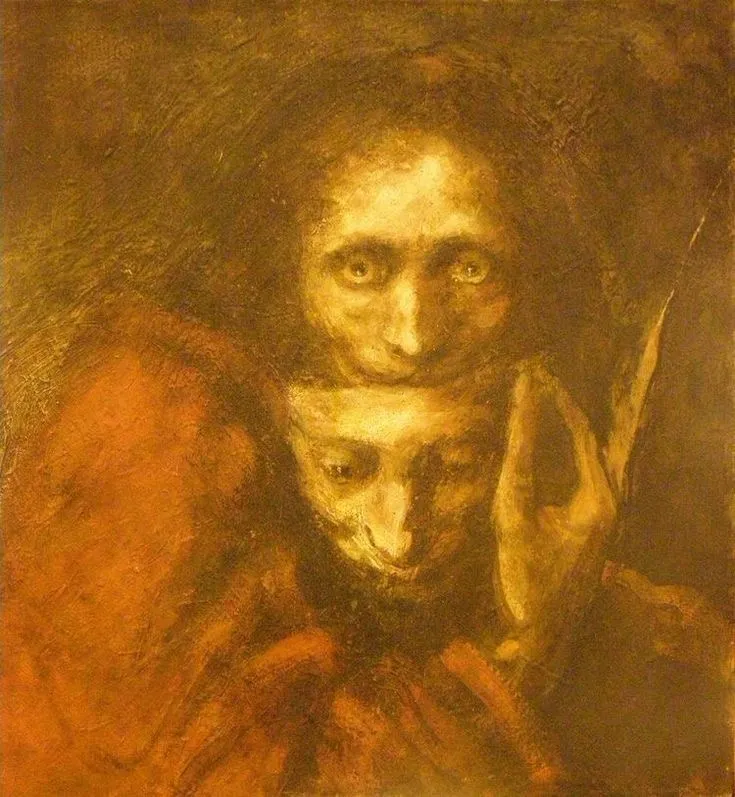The Hollow Gaze: On the Terror of Masks

There is something unholy about a face that does not move.
It watches you from across the room — pale, frozen, silent. A mask. Just plastic, just paint. And yet it hums with menace. It is not merely that you cannot see who is beneath it — it is that you begin to wonder if there is anyone beneath it at all.
Masks have always frightened us. From the faceless killers of slasher films to the ceremonial disguises of ancient rites, they haunt our imagination with quiet persistence. But what is it, exactly, that makes a mask so unnerving? The answer lies not in what it hides, but in what it suggests: that identity is a fragile illusion, and that behind the human face might lie not a soul, but a void.
We are trained from birth to read faces. A furrowed brow, a trembling lip, a sudden smile — these are the lexicons of intimacy and recognition. We trust faces to tell us who someone is, and how they feel. A face is the closest thing we have to proof that a consciousness resides within.
So when a mask replaces the face, something in us recoils. The usual channels of empathy are severed. There are no eyes to meet. No expressions to mirror. And in this absence, the mind begins to invent. We project fear into the blankness. We imagine intentions, threats, monstrosities. The mask becomes a canvas for dread.
The horror is not only that we cannot see the person — it is that we cannot even feel them.
In horror, the mask is not just concealment. It is transformation. When Michael Myers dons his pale mask in Halloween, he becomes more than human — or perhaps less. He is emptied of personality, of motive, of humanity. The mask grants him a kind of mythic detachment. He does not rage. He does not gloat. He simply is — moving like a force of nature, emotionless and inevitable.
The terror of the mask lies in its refusal to respond. It renders the human unreadable. And in doing so, it turns the wearer into a monster not by what they do — but by what they no longer are.
This is the essence of the uncanny: the thing that is almost human, but not quite. A doll’s face. A ventriloquist dummy. A mask in the dark. Horror thrives here, in the breach between familiarity and strangeness. The face should be alive. When it is not, we sense a rupture in the natural order — and our bodies react as if to a predator.
Long before cinema, masks were used to invoke gods, spirits, and ancestors. In ritual, the mask was not a disguise, but an invitation — to be possessed, to channel something beyond oneself. The one who wears the mask becomes not a person playing a part, but a vessel for forces that defy comprehension.
This ancient fear lives on in horror cinema. Leatherface in The Texas Chain Saw Massacre wears the skin of his victims as a grotesque mask — a performance of identity stitched from the dead. In Eyes Without a Face, the mask hides not a monster, but a ruined beauty — and yet it is no less frightening, because the blankness disorients. It denies us narrative.
In these stories, the mask is not just a tool. It is a character. It consumes the wearer.
In modern life, we wear metaphorical masks every day: the professional, the friend, the partner, the stranger. We shift and shape ourselves to fit the social script. But horror dares to ask: what if there’s nothing underneath? What if the masks are all there is?
This is the true abyss the horror mask opens before us: depersonalization. Ghostface can be anyone. The killer in the animal mask could be your neighbor, your friend, your reflection. We are no longer unique. We are replaceable. We are echoes in latex.
And as we stare into the hollow eyes of the mask, we begin to feel it stare back — as if daring us to admit that we too are wearing one. That maybe we always were.
A mask pretends to be a face, but it does not feel. It watches, but it does not blink. It kills, but it does not scream.
We fear masks not just because they hide — but because they reveal. They expose our reliance on the visible, our hunger for the knowable. They mock the illusion that we can ever truly see one another.
In the end, the terror of the mask is existential. It whispers that identity is not fixed, but worn. That the self can be stripped, swapped, or silenced. And that behind the face — behind every face — there might be only the abyss.